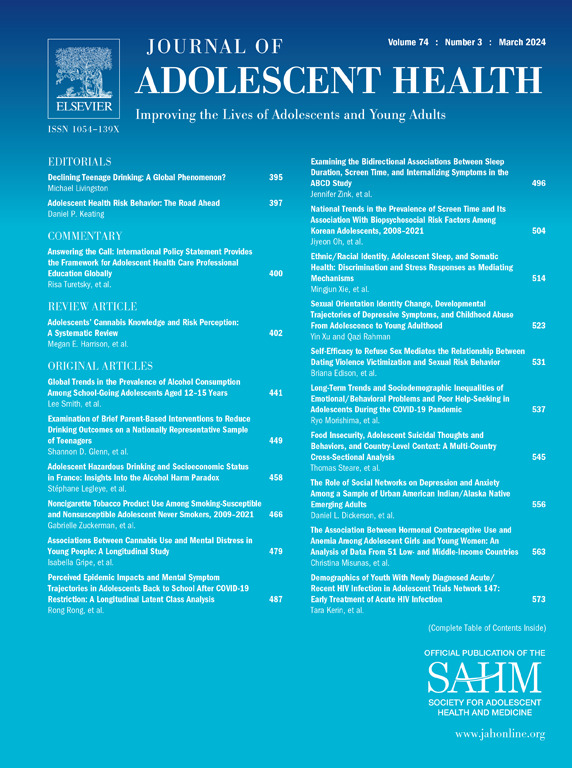历史上的结构性种族主义与青少年感知到的压力。
IF 5.5
2区 医学
Q1 PEDIATRICS
引用次数: 0
摘要
目的:本研究首次探讨了历史上的结构性种族主义对当今青少年感知压力的影响。方法:数据来源于青少年到成人神经发育研究。15 ~ 17岁青少年213人完成了应激感知量表(PSS-14)。回归模型检验了红线评分(住宅安全风险的衡量标准)与PSS-14之间的关联。结构方程模型被用来检验当代邻里不平等的间接影响。结果:调整协变量后,生活在高红线束的青少年(52.1%)报告的PSS-14值高于生活在未分级束的青少年(β: 2.47, 95%置信区间:0.35,4.59)。对非西班牙裔黑人青少年的分析也显示了类似的结果。社区贫困对感知压力有间接影响(p = 0.043)。讨论:研究结果表明,20世纪初的制度性歧视性贷款做法继续影响着当今的社区贫困,导致青少年压力增加。本文章由计算机程序翻译,如有差异,请以英文原文为准。
Historic Structural Racism and Perceived Stress in Adolescents
Purpose
This study is the first to examine the impact of structural racism from historic redlining practices on present-day perceived stress in adolescents.
Methods
Data come from the Study of Adolescent to Adult Neural Development. Adolescents aged 15–17 years (N = 213) completed the Perceived Stress Scale (PSS-14). Regression models examined associations between redlining scores, a measure of residential security risk, and PSS-14. Structural equation modeling was used to examine the indirect effect of present-day neighborhood inequities.
Results
After adjusting for covariates, adolescents living in high redlined tracts (52.1%) reported higher PSS-14 values than those living in ungraded tracts (β: 2.47, 95% confidence interval: 0.35, 4.59). Analyses subset to non-Hispanic Black adolescents showed similar results. There was an indirect effect of redlining on perceived stress through neighborhood poverty (p = .043).
Discussion
Findings indicate that institutional discriminatory lending practices from the early 20th century continue to impact present-day neighborhood poverty, resulting in increased adolescent stress.
求助全文
通过发布文献求助,成功后即可免费获取论文全文。
去求助
来源期刊

Journal of Adolescent Health
医学-公共卫生、环境卫生与职业卫生
CiteScore
10.40
自引率
3.90%
发文量
526
审稿时长
46 days
期刊介绍:
The Journal of Adolescent Health is a scientific publication dedicated to enhancing the health and well-being of adolescents and young adults. Our Journal covers a broad range of research topics, spanning from the basic biological and behavioral sciences to public health and policy. We welcome a variety of contributions, including original research papers, concise reports, literature reviews, clinical case reports, opinion pieces, and letters to the editor. We encourage professionals from diverse disciplines such as Anthropology, Education, Ethics, Global Health, Health Services Research, Law, Medicine, Mental and Behavioral Health, Nursing, Nutrition, Psychology, Public Health and Policy, Social Work, Sociology, and Youth Development to share their expertise and contribute to our mission of promoting adolescent health. Moreover, we value the voices of young individuals, family and community members, and healthcare professionals, and encourage them to submit poetry, personal narratives, images, and other creative works that provide unique insights into the experiences of adolescents and young adults. By combining scientific peer-reviewed research with creative expressions, our Journal aims to create a comprehensive understanding of the challenges and opportunities in adolescent and young adult health.
 求助内容:
求助内容: 应助结果提醒方式:
应助结果提醒方式:


